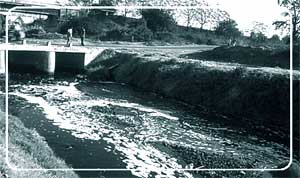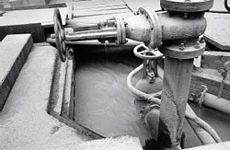Just use it
Poor laws and regulations and lack of coordination between regulatory bodies worsen
the water crisis
There is no concrete
government policy on industrial water use. The existing policies are merely a atchwork of
public health and water availability concerns.
Regulating
use
 GLOBAL: Countries across the world set water
consumption standards and targets for industries to achieve, and regularly revise the
standards in a bid to control water use. China, for instance, sets water targets for major
water consuming industrial sectors. According to the report of China Water Conservation
Agency, the first national quotas for industrial water consumption will push companies to
save as much as 6 billion cubic meters of water a year by 2005. Similar water saving
targets are fixed across the developed world. GLOBAL: Countries across the world set water
consumption standards and targets for industries to achieve, and regularly revise the
standards in a bid to control water use. China, for instance, sets water targets for major
water consuming industrial sectors. According to the report of China Water Conservation
Agency, the first national quotas for industrial water consumption will push companies to
save as much as 6 billion cubic meters of water a year by 2005. Similar water saving
targets are fixed across the developed world.
INDIA: In India, as of now, there is no
law determining the exact amount of water meant for consumption by the various industrial
sectors. Though CPCB has prescribed water consumption levels for some industrial sectors,
they are mere recommendations and cannot be enforced by laws. India also has some obsolete
laws related to groundwater extraction. In Indian law, the person who owns the land also
owns the groundwater below. Though this law has some relevance as far as the domestic
groundwater use is concerned, it is outright absurd for industrial and commercial use. The
result is that today, industries withdraw groundwater that remains unregulated and
unpriced.
Regulating
pollution
GLOBAL:
Regulators are shifting from concentration-based standards to pollution load based
standards. The pollution load-based standards determine the total amount of pollutant
generated for per unit production. The pollution load-based standards also use the quota
system for the amount of water allowed to various industries and therefore, with this
standard pollution levels are monitored, as also the amount of freshwater consumed. This
forces companies to reduce fresh water consumption as they save on water cost. Also, by
introducing 'polluter pays principle' regulators push companies to reduce the total
pollution load. Therefore, with the help of pollution load-based standards coupled with
the 'polluter pays principle', regulators across the world are reducing fresh water
consumption as well as water pollution by industries.
 INDIA: In
India both these principles are absent. The result is that industries use more freshwater
and discharge more pollutants through wastewater and still meet the legal standards. The
industrial water pollution standards in the country are concentration based, that is, they
measure the concentration of pollution in a given quantity of water. The result is that an
industry can meet the required standard merely by diluting the effluent with clean water.
Since the cost of water is low, it makes more economic sense for an industry to dilute the
effluent than to treat it to meet the standards. l INDIA: In
India both these principles are absent. The result is that industries use more freshwater
and discharge more pollutants through wastewater and still meet the legal standards. The
industrial water pollution standards in the country are concentration based, that is, they
measure the concentration of pollution in a given quantity of water. The result is that an
industry can meet the required standard merely by diluting the effluent with clean water.
Since the cost of water is low, it makes more economic sense for an industry to dilute the
effluent than to treat it to meet the standards. l
National Water Policy: Industry is let off!
The issues related to the industrial water have been addressed in vague and
fragmented form in National Water Policy (NWP) released in 2002. No clear vision for
regulating and controlling industrial water use has been given. The policies stated in
NWP, 2002 are just not sufficient to result in modern control and regulation of the
industrial water use as an integrated whole.
The entire document of 6000
words mentions industry just 6 times, unmindful of the environmental concerns industrial
water use poses.
Water
policy says:
  Effluents should be treated to levels and standards
that are acceptable before discharging them into natural streams. Effluents should be treated to levels and standards
that are acceptable before discharging them into natural streams.
Comment: Does not address the issue of pollution load.
The current standards for industrial effluents are concentration- based, which does not
provides incentive for reducing water use or pollution loads.
 Principle of 'polluter pays' should be followed in management of polluted water.
Principle of 'polluter pays' should be followed in management of polluted water.
Comment: Advocates 'polluter pays' principle' but is
silent on extent of payment. Current water cess charged by pollution control boards is a
'polluter pays' regime, but the quantum of payment is so low that there is no incentive or
disincentive for the industry for reducing wastewater discharge and hence water use.
 Economic development and activities, including agriculture, industry and urban
development, should be planned with due regard to the constraints imposed by the
configuration of water availability. There should be a water zoning of the country and the
economic activities should be guided and regulated in accordance with such zoning.
Economic development and activities, including agriculture, industry and urban
development, should be planned with due regard to the constraints imposed by the
configuration of water availability. There should be a water zoning of the country and the
economic activities should be guided and regulated in accordance with such zoning.
Comment: Unless addressed in the industrial policy, it
has no significance.
 Efficiency of utilisation in all the diverse uses of water should be optimised and an
awareness of water as a scarce resource should be fostered. Conservation consciousness
should be promoted through education, regulation, incentives and disincentives.
Efficiency of utilisation in all the diverse uses of water should be optimised and an
awareness of water as a scarce resource should be fostered. Conservation consciousness
should be promoted through education, regulation, incentives and disincentives.
Comment: Vague and indifferent.
 The
resources should be conserved and the availability augmented by maximising retention,
eliminating pollution and minimising losses. For this, measures such as selective linings
in the conveyance system, modernisation and rehabilitation of existing systems including
tanks, recycling and re-use of treated effluents and adoption of traditional techniques
like mulching or pitcher irrigation and new techniques like drip and sprinkler may be
promoted, wherever feasible. The
resources should be conserved and the availability augmented by maximising retention,
eliminating pollution and minimising losses. For this, measures such as selective linings
in the conveyance system, modernisation and rehabilitation of existing systems including
tanks, recycling and re-use of treated effluents and adoption of traditional techniques
like mulching or pitcher irrigation and new techniques like drip and sprinkler may be
promoted, wherever feasible.
Comment: Vague and indifferent.
|

 GLOBAL: Countries across the world set water
consumption standards and targets for industries to achieve, and regularly revise the
standards in a bid to control water use. China, for instance, sets water targets for major
water consuming industrial sectors. According to the report of China Water Conservation
Agency, the first national quotas for industrial water consumption will push companies to
save as much as 6 billion cubic meters of water a year by 2005. Similar water saving
targets are fixed across the developed world.
GLOBAL: Countries across the world set water
consumption standards and targets for industries to achieve, and regularly revise the
standards in a bid to control water use. China, for instance, sets water targets for major
water consuming industrial sectors. According to the report of China Water Conservation
Agency, the first national quotas for industrial water consumption will push companies to
save as much as 6 billion cubic meters of water a year by 2005. Similar water saving
targets are fixed across the developed world. INDIA: In
India both these principles are absent. The result is that industries use more freshwater
and discharge more pollutants through wastewater and still meet the legal standards. The
industrial water pollution standards in the country are concentration based, that is, they
measure the concentration of pollution in a given quantity of water. The result is that an
industry can meet the required standard merely by diluting the effluent with clean water.
Since the cost of water is low, it makes more economic sense for an industry to dilute the
effluent than to treat it to meet the standards. l
INDIA: In
India both these principles are absent. The result is that industries use more freshwater
and discharge more pollutants through wastewater and still meet the legal standards. The
industrial water pollution standards in the country are concentration based, that is, they
measure the concentration of pollution in a given quantity of water. The result is that an
industry can meet the required standard merely by diluting the effluent with clean water.
Since the cost of water is low, it makes more economic sense for an industry to dilute the
effluent than to treat it to meet the standards. l